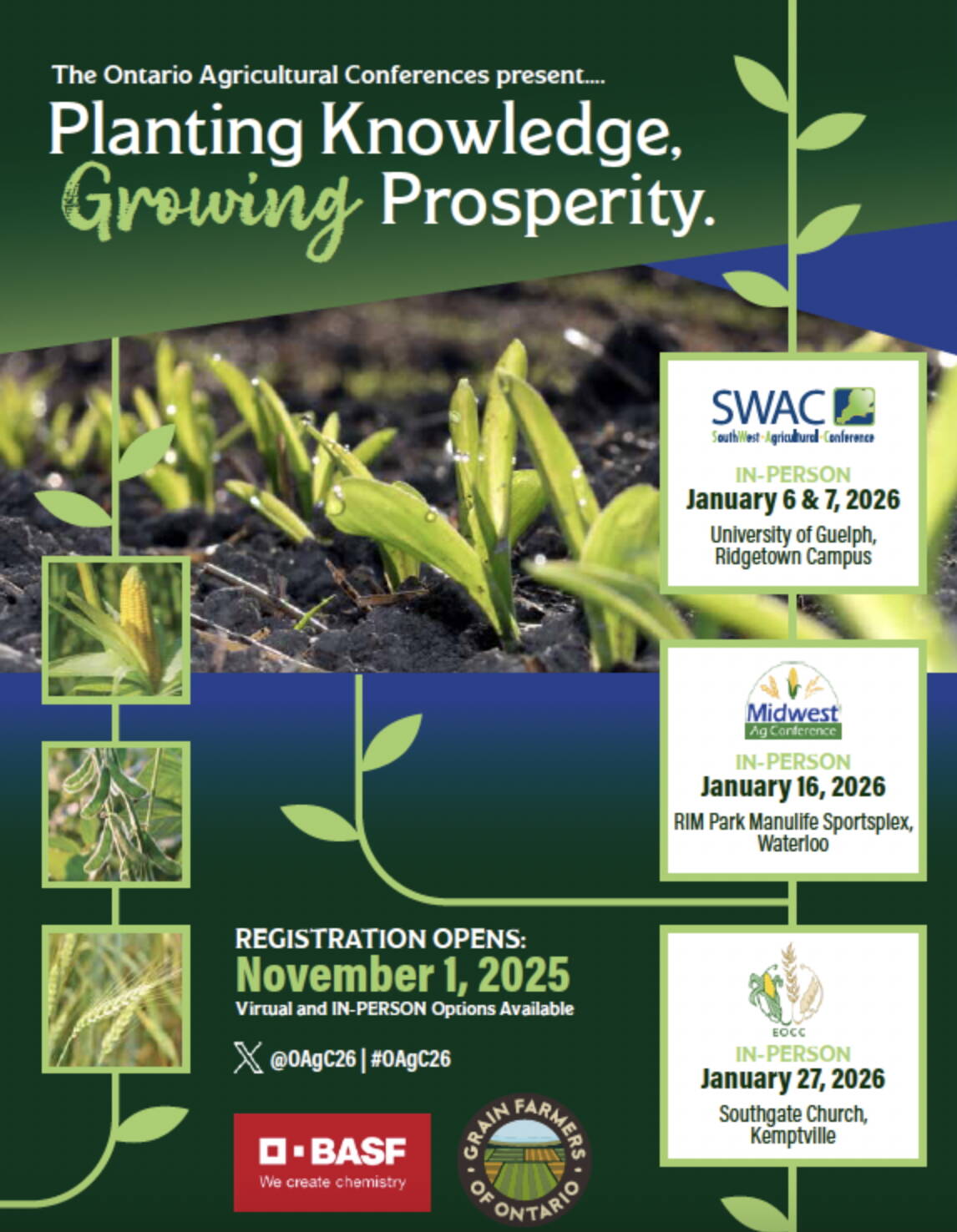Ontario received average precipitation in March, and temperatures were four to six degrees above normal. Soil and weather conditions are favourable for planting corn and soybeans and planting of row crops is expected to occur seven days earlier than normal. Winter wheat is developing in an optimal environment.
Quick look
Soybeans: A historically low carryout of on-farm stocks is projected.
Corn: The market will be sensitive to weather during the growing season.
Wheat: Russia is on track to produce the fourth bumper crop in a row.
Farmer selling has slowed for old-crop corn, soybeans and wheat. Commercial ownership has been sufficient to satisfy domestic and export demand. However, the market needs to pull stocks off-farm for the April through July demand.
Read Also

Registration open for Ontario Agricultural Conference
The Ontario Agricultural Conference 2026 offers in-person and online access to expert insights, hands-on learning, and networking opportunities.
The inverse in the soybean market is telling farmers to liquidate old crop stocks. The corn market is telling farmers to sell now for delivery in June or July. Export demand for corn is expected to increase in spring. This week we’re advising farmers to increase wheat sales.
The USDA released its Prospective Plantings Survey on March 28. U.S. farmers will plant more soybeans and less corn this spring. U.S. soft red winter wheat acres are expected to come in at 6.3 million, down from the 2023 planted area of 7.6 million acres.
There is no weather premium in the North American grain and oilseed markets. We continue to forecast La Nina conditions, which often result in drier conditions in the western half of the U.S. corn belt. The Brazilian soybean harvest was estimated to be 75 per cent complete as of March 31.
Brazil’s second corn crop has experienced drier conditions through March. Acreage for this safrinha crop is estimated to be down eight to 10 per cent from last year. The Argentinean corn harvest was about six per cent at the end of March but minimal progress has been made on soybeans. Recent storms have delayed Argentina’s harvest progress and caused quality deterioration.
Throughout March, the Canadian dollar traded in a range with support at US$0.0735 and resistance at $0.0745. We have a neutral to negative outlook for the resource-based currency. Weaker consumer spending, along with a slowdown in central Canadian manufacturing, will stifle growth.
The Bank of Canada is expected to decrease its benchmark lending rate in the summer, ahead of the U.S. Federal Reserve. Widening of the interest rate differential between Canada and the U.S., softer economic growth and Liberal fiscal policy will result in Canadian dollar depreciation against the U.S. greenback.
Soybeans
Statistics Canada will release its March 31 Stocks Report on May 7. As of March 31, Ontario on-farm soybean stocks were estimated at 650,000 tonnes, while commercial stocks were expected to come in at 600,000 tonnes. The Ontario domestic soybean crush from April through July is expected to average 140,000 tonnes per month for a total domestic demand of 560,000 tonnes.
Ontario soybean exports are estimated at 450,000 tonnes for the same four-month period. Total export and domestic demand from April 1 through July 31 is estimated at 1.01 million tonnes. The market needs to attract farmer selling.
Basis levels are expected to strengthen to pull stocks off-farm, which will limit the downside in the domestic market because this is the period when the Ontario market also attracts imports from the U.S.
There is an inverse between old and new crop prices. The market is telling farmers not to store old crop supplies into new-crop positions. We’re projecting an Ontario on-farm carryout of 7,000 tonnes for the 2023-24 campaign, which is a historical low.
Export values are relatively unchanged from mid-March. On March 31, Brazilian soybeans were offered at US$424/tonne f.o.b. Paranagua, up $3/tonne from two weeks earlier. U.S. soybeans were quoted at $462/tonne f.o.b. the Gulf, down $2/tonne from mid-March. Argentine soybeans were offered at $432/tonne f.o.b., up $5/tonne from the previous issue.
Ontario soybeans were quoted at US$460/tonne f.o.b. St. Lawrence port. The Ontario domestic market needs to ration demand away from export channels due to tighter ending stocks. The domestic market also needs to trade high enough to encourage imports from the U.S.
South American production is basically confirmed by this time of year. Brazilian output is estimated at 155 million tonnes, down seven million tonnes from last year. Argentine soybean production is estimated at 50 million tonnes, which is double last years output.
South American farmers have sold what they plan to move at harvest. Harvest pressure from South America is easing and the market will have breathing room to move higher.
China will be a major buyer of Brazilian soybeans over the next two months, shying away from U.S. origin due to the price structure. Argentina is a major exporter of soyoil and soymeal but only moves about five million tonnes offshore, which isn’t sufficient to alter the price structure.
U.S. farmers intend to plant 86.5 million acres, up 2.9 million acres from last year. Using a traditional abandonment rate and a five-year average yield, production has potential to reach 116 million tonnes, up only 2.9 million tonnes from the 2023 crop and up only 2.4 million tonnes from the five-year average production.
The market will be sensitive to weather during the growing season as the market cannot afford below average yields. Otherwise, the carryout becomes very tight.
What to do: We’ve advised farmers to be 80 per cent sold on their 2023 production and 20 per cent sold on new crop. We’re waiting for the soybean market to incorporate a weather premium before making our final sale. We usually wait until the upcoming crop is more certain. South American harvest pressure is easing, allowing the market some breathing room to move higher. The focus is on U.S. production.
Corn
Ontario corn stocks as of March 31 are expected to come in at 5.8 million tonnes. This includes 2.5 million tonnes on farms and 3.3 million tonnes in commercial positions. Total domestic demand from April 1 through Aug. 31 is expected to be 3.9 million tonnes. while exports are projected to reach 900,000 tonnes.
Total demand from April 1 through Aug. 31 is estimated at 4.8 million tonnes. There will be just under one million tonnes of corn in Ontario as of Aug. 31. This includes 425,000 tonnes on farm and 550,000 tonnes in commercial positions. Basis levels for corn are expected to increase.
The domestic market needs to move high enough to curb exports and also attract 200,000 tonnes of imports. Otherwise, on-farm stocks drop to fairly low levels. The Ontario corn market cannot afford a crop problem during the 2024 growing season or the domestic market will trade at a significant premium over world values.
On March 31, U.S. corn was offered at US$192/tonne f.o.b. the Gulf while Brazilian corn was quoted at $190/tonne f.o.b. Paranagua. Argentinean corn was valued at $187/tonne f.o.b. There is strong export demand for U.S. corn. U.S export sales have been running over one million tonnes per week and total commitments are up 19 per cent over last year.
Ontario corn is quoted at US$188/tonne f.o.b. St. Lawrence port. French corn is valued at $215/tonne f.o.b. La Pallice. Ontario corn is competitive with French origin into Northern European ports. There is limited downside to the Ontario market as long as export demand keeps pulling corn offshore. During the summer, Ontario corn needs to trade at a premium to French origin.
U.S. farmers will plant 90 million acres of corn this spring, according to the USDA. Using a traditional abandonment rate and a five-year average yield, production has potential to come in at 363 million tonnes, down from the 2023 output of 390 million tonnes and down marginally from the five-year average of 365 million tonnes. This lower U.S. production estimate comes on the heels of a year-over-year decline in Brazilian production.
Brazil’s safrinha corn acreage is expected to be down 8-10 per cent from last year. Brazil’s first corn crop was estimated at 20 million tonnes and the second crop will likely finish around 94 million tonnes, for a total crop size of 114 million tonnes. This is down from 137 million tonnes last year.
We feel comfortable with the USDA estimate of 56 million tonnes for Argentina. This compares to last year’s crop of 36 million tonnes. It’s important to realize that safrinha supplies will only be available for export in July, while the Argentinean surplus will come on the market in June. The U.S. needs to carry the world for its corn requirements for April and May.
For Ontario producers, the French corn crop is expected to reach 13.8 million tonnes, up from the 2023 crop size of 12.8 million tonnes. Total EU corn production is expected to be up seven to eight million tonnes from last year, according to trade estimates.
What to do: Our sales strategy for corn is unchanged from the previous issue. We’re 60 per cent sold on the 2023 production and plan to sell the next 20 per cent increment in late April. For new crop, the fundamentals suggest we could see $1/bu. upside potential from current levels. The corn market will be very sensitive to U.S. weather this summer. A weather rally will provide a prime opportunity for new crop sales.
Wheat
Chicago wheat futures were trading at four-year lows during March. The lower prices caused China to cancel sales from the U.S. and Australia. This cancellation, along with aggressive offers from Russia, have kept the wheat market under pressure. From a historical and psychological perspective, when China cancels sales, this is usually the low of the market. Russia is selling the bulk of its wheat at the lows.
The managed money has been short for wheat futures throughout the winter and spring. The largest short position from the speculative community usually occurs at the lowest levels. Farmers need to take the opposite view as the most negative news comes forward when the market is at the low.
China has a problem with its winter wheat crop. Warmer temperatures through the winter resulted in above average abandonment rate. Precipitation has been variable through March and we’re expecting a year-over-year decline in Chinese winter wheat production.
Indian production is uncertain as harvest begins. Crop reports are variable after a drier winter. Remember, India is coming off a historically low carryout so there is no supply cushion.
French soft wheat production estimates range from 31.5 to 33 million tonnes, down from last year’s crop of 35 million tonnes. German output is estimated at 19 million tonnes, down from the year-ago output of 21.3 million. Lower wheat production in Europe is supportive for Ontario corn prices as nearly 40 per cent of the wheat crop trades into feed channels.
After the USDA acreage report, we are projecting U.S. soft red winter wheat production to finish near 8.7 million tonnes, down from the 2023 crop of 12.2 million tonnes. U.S. hard red winter production is estimated at 19.4 million tonnes, up from last year’s drought output of 15.9 million tonnes.
Seasonal rains come across the U.S. southern plains in April, so this is when the crop is made. The next month is critical for U.S. production.
Russia is on track to produce the fourth bumper crop in a row. However, the weather forecast for April 15 through May 15 calls for drier conditions in the main Russian winter wheat region. The southern Ukraine region and southern Russia have a drier forecast for June. There are weather concerns for the world’s largest winter wheat growing regions.
Ontario winter wheat production is expected to finish in the range of 1.8 to two million tonnes, down from the 2023 crop of 2.7 million tonnes. We will only know the abandonment percentage later in spring. There could be some surprises once the final harvested area is more certain.
What to do: This week, we’re advising Ontario farmers to increase wheat sales by 10 per cent, bringing total sales to 80 per cent. We will sell the final 20 per cent of the crop in late April or early May once the Russian and U.S. weather forecasts are more certain. The bulk of the Northern Hemisphere wheat production will be determined during April and May weather. This is the critical period; there is no room for adverse conditions or the market will experience a major rally from the lows.















